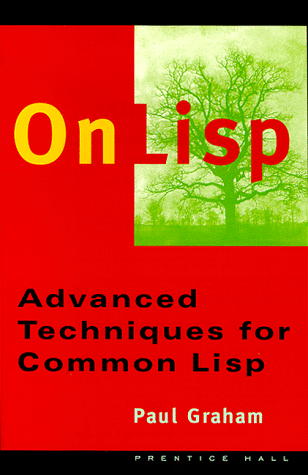| UMBC CMSC 331 Principles of Programming Languages |

Paul Graham, On Lisp, Prentice Hall, 1993, 432 pages, paperbound. ISBN 0130305529.
On Lisp is a comprehensive study of advanced Lisp techniques, with bottom-up programming as the unifying theme. It gives the first complete description of macros and macro applications. The book also covers important subjects related to bottom-up programming, including functional programming, rapid prototyping, interactive development, and embedded languages. The final chapter takes a deeper look at object-oriented programming than previous Lisp books, showing the step-by-step construction of a working model of the Common Lisp Object System (CLOS). As well as an indispensable reference, On Lisp is a source of software. Its examples form a library of functions and macros that readers will be able to use in their own Lisp programs.
Paul Graham's site for the book.
1.
The Extensible Language 1
1.1. Design by Evolution 1
1.2. Programming Bottom-Up 3
1.3. Extensible Software 5
1.4. Extending Lisp 6
1.5. Why Lisp (or When) 8
2.
Functions 9
2.1. Functions as Data 9
2.2. Defining Functions 10
2.3. Functional Arguments 13
2.4. Functions as Properties 15
2.5. Scope 16
2.6. Closures 17
2.7. Local Functions 21
2.8. Tail-Recursion 22
2.9. Compilation 24
2.10. Functions from Lists 27
3.
Functional Programming 28
3.1. Functional Design 28
3.2. Imperative Outside-In 33
3.3. Functional Interfaces 35
3.4. Interactive Programming 37
4.
Utility Functions 40
4.1. Birth of a Utility 40
4.2. Invest in Abstraction 43
4.3. Operations on Lists 44
4.4. Search 48
4.5. Mapping 53
4.6. I/O 56
4.7. Symbols and Strings 57
4.8. Density 59
5.
Returning Functions 61
5.1. Common Lisp Evolves 61
5.2. Orthogonality 63
5.3. Memoizing 65
5.4. Composing Functions 66
5.5. Recursion on Cdrs 68
5.6. Recursion on Subtrees 70
5.7. When to Build Functions 75
6.
Functions as Representation 76
6.1. Networks 76
6.2. Compiling Networks 79
6.3. Looking Forward 81
7.
Macros 82
7.1. How Macros Work 82
7.2. Backquote 84
7.3. Defining Simple Macros 88
7.4. Testing Macroexpansion 91
7.5. Destructuring in Parameter Lists 93
7.6. A Model of Macros 95
7.7. Macros as Programs 96
7.8. Macro Style 99
7.9. Dependence on Macros 101
7.10. Macros from Functions 102
7.11. Symbol Macros 105
8.
When to Use Macros 106
8.1. When Nothing Else Will Do 106
8.2. Macro or Function? 109
8.3. Applications for Macros 111
9.
Variable Capture 118
9.1. Macro Argument Capture 118
9.2. Free Symbol Capture 119
9.3. When Capture Occurs 121
9.4. Avoiding Capture with Better Names 125
9.5. Avoiding Capture by Prior Evaluation 125
9.6. Avoiding Capture with Gensyms 128
9.7. Avoiding Capture with Packages 130
9.8. Capture in Other Name-Spaces 130
9.9. Why Bother? 132
10.
Other Macro Pitfalls 133
10.1. Number of Evaluations 133
10.2. Order of Evaluation 135
10.3. Non-functional Expanders 136
10.4. Recursion 139
11.
Classic Macros 143
11.1. Creating Context 143
11.2. The with- Macro 147
11.3. Conditional Evaluation 150
11.4. Iteration 154
11.5. Iteration with Multiple Values 158
11.6. Need for Macros 161
12.
Generalized Variables 165
12.1. The Concept 165
12.2. The Multiple Evaluation Problem 167
12.3. New Utilities 169
12.4. More Complex Utilities 171
12.5. Defining Inversions 178
13.
Computation at Compile-Time 181
13.1. New Utilities 181
13.2. Example: Bezier Curves 185
13.3. Applications 186
14.
Anaphoric Macros 189
14.1. Anaphoric Variants 189
14.2. Failure 195
14.3. Referential Transparency 198
15.
Macros Returning Functions 201
15.1. Building Functions 201
15.2. Recursion on Cdrs 204
15.3. Recursion on Subtrees 208
15.4. Lazy Evaluation 211
16.
Macro-Defining Macros 213
16.1. Abbreviations 213
16.2. Properties 216
16.3. Anaphoric Macros 218
17.
Read-Macros 224
17.1. Macro Characters 224
17.2. Dispatching Macro Characters 226
17.3. Delimiters 227
17.4. When What Happens 229
18.
Destructuring 230
18.1. Destructuring on Lists 230
18.2. Other Structures 231
18.3. Reference 236
18.4. Matching 238
19.
A Query Compiler 246
19.1. The Database 247
19.2. Pattern-Matching Queries 248
19.3. A Query Interpreter 250
19.4. Restrictions on Binding 252
19.5. A Query Compiler 254
20.
Continuations 258
20.1. Scheme Continuations 258
20.2. Continuation-Passing Macros 266
20.3. Code-Walkers and CPS Conversion 272
21.
Multiple Processes 275
21.1. The Process Abstraction 275
21.2. Implementation 277
21.3. The Less-than-Rapid Prototype 284
22.
Nondeterminism 286
22.1. The Concept 286
22.2. Search 290
22.3. Scheme Implementation 292
22.4. Common Lisp Implementation 294
22.5. Cuts 298
22.6. True Nondeterminism 302
23.
Parsing with ATNs 305
23.1. Background 305
23.2. The Formalism 306
23.3. Nondeterminism 308
23.4. An ATN Compiler 309
23.5. A Sample ATN 314
24.
Prolog 321
24.1. Concepts 321
24.2. An Interpreter 323
24.3. Rules 329
24.4. The Need for Nondeterminism 333
24.5. New Implementation 334
24.6. Adding Prolog Features 337
24.7. Examples 344
24.8. The Senses of Compile 346
25. Object-Oriented Lisp 348
25.1. Plus c¸a Change 348
25.2. Objects in Plain Lisp 349
25.3. Classes and Instances 364
25.4. Methods 368
25.5. Auxiliary Methods and Combination 374
25.6. CLOS and Lisp 377
25.7. When to Object 379